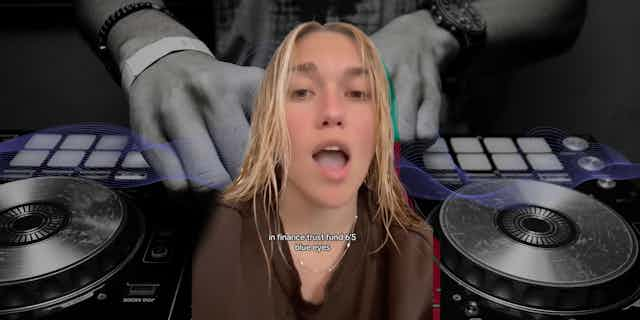“I’m looking for a man in finance,” the TikTok user, @girl_on_couch, says blandly, looking around the room and then into the camera. “Trust fund. 6'5. Blue eyes. Finance.” In the caption, she urges someone to turn her sound bite into “an actual song plz”.
From this little bit of spoken audio sprang the song that’s suddenly everywhere on social media: I’m looking for a man in finance.
A quick browse on Spotify reveals several music producers, such as Billen Ted, Hiko and Ketno, have since featured this spoken phrase on various dance tracks. Billen Ted even show how they did it.
The result is undeniably an earworm – a song that all-too-easily gets stuck in your head. On TikTok and Instagram, users are making their versions of the song, dancing to it around lounge rooms or dance festivals, or muttering adaptations of it as they work or multitask.
Sampled speech in song
It is, of course, not the first time a little bit of spoken audio has formed the central pillar of a wildly popular dance track.
Remember Get on the Beers? This viral track sampled a then-Victorian Premier Dan Andrews speech imploring people to stay home during the early days of the COVID pandemic. The song, by Mashd N Kutcher, was later described as “an unofficial anthem for Melbournians coming out of lockdown”.
Older readers will remember Pauline Pantsdown’s I don’t like it, which cheekily included unauthorised vocal samples from conservative politician Pauline Hanson.
Another memorable example is The Avalanches’ hugely acclaimed song Frontier Psychiatrist, with its surreal mix of samples and repeated spoken refrain: “that boy needs therapy”.
So what makes a great speech sample in a song, and why are they often so memorable?
Recogniseable but recontextualised
I’m a music researcher with a special interest in earworms, and wrote about memorable audio samples in my book with Jadey O'Regan, Hooks in Popular Music.
As we argue in our book, an audio sample such as “I’m looking for a man in finance” has to capture our attention and be memorable to be a hook. There is a barrage of noise on the internet and in our phones. For a sample to rise above that barrage, it has to have attention-grabbing audio properties, but also fit with our expectations and desires.
One way to become salient and memorable in this way is by being recognisable but recontextualised. If we already have some memory of a particular bit of spoken word, then hearing it in a new context such as a dance song will more easily capture our attention. We respond to what we recognise. Many people had seen and heard the original @girl_on_couch TikTok, so recognised it readily in the dance tracks that sampled it.
Another way to become salient and memorable is to reflect the way we feel, or the way we want to feel. Get on the Beers is another great example.
Australians were glued to their TVs to hear the daily speeches of state premiers during COVID lockdowns. It was a tense time. A lot of the big hits in that lockdown era were quite sad songs about being lonely, such as The Weeknd’s Blinding Lights and Heatwaves by Glass Animals.
Then Get on the Beers, which originally came out in 2020, experienced a surge of popularity as lockdowns ended. Thanks to some creative remixing, Dan Andrews seemed now to urge us to get to the pub asap. His soundbite was recognisable but recontextualised, in a track that felt cathartic for a populace very sick of lockdowns.
Accent, cadence and rhythm
The other thing that can make a speech sound bite memorable and ripe for remix in a song has to do with patterns of speech. That includes tone of voice and accent (there’s something catchy about @girl_on_couch’s deliberately hammed-up valley girl Californian accent, with all its vocal fry).
A staccato rhythm, an accidental rhyme, the cadence of a sentence – factors like these can conspire to create a line that is unusual, memorable and endlessly repeatable.
Southend’s song The Winner Is…, which focuses on the moment it was announced Sydney would host the 2000 Olympics, is another example. It captures a moment of celebration and release.
It’s hard to know whether this song would have been as popular if it wasn’t for the brilliantly memorable way former Olympics chief Juan Antonio Samaranch, originally from Spain, pronounced the word “Sydney”.
Speech as music
When you sample some speech and put it on a loop, people stop paying attention to the meaning of the words. They start paying attention to the sound, rhythm and melody of the voice. People hear speech as music.
This is what Diana Deutsch, a professor of psychology at the University of California, called the “speech-to-song illusion”. Her research looked at how the phrase “sometimes behave so strangely” suddenly appears “to burst into song”, even if no other musical elements are added.
That is playing a role in all successful spoken samples. The effect is even stronger once you emphasise the rhythm of speech by putting it to a dance beat.
Add in the viral power of TikTok, which makes it easier than ever for users to rework and recontextualise video and audio, and it’s no great surprise I’m looking for a man in finance has become such an earworm.

